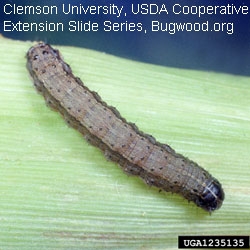Fall armyworm
Order: Lepidoptera
Family: Noctuidae
Genus and species: Spodoptera frugiperda (J. E. Smith)

The fall armyworm is frequently a pest in the Deep South. The caterpillars feed on grasses and low-growing forbs and woody plants, including many field crops, such as rice, soybeans, alfalfa, corn, clover, cotton, and tobacco. They are among the most devastating pests of pastures and hayfields. Lush fields of bermudagrass seem to be preferred, but corn and sorghum are also susceptible to destruction. Young larvae often go unnoticed because they do not consume a lot of plant material, but more mature larvae are voracious eaters, and damage can appear almost overnight. When infestations are high, the caterpillars defoliate the preferred host and, like other armyworms, they disperse in large number and consume nearly all vegetation in their path.
Young larvae are green with a black head capsule. The body soon turns brown, and white lateral lines start to show. In more mature larvae, the head capsule becomes reddish brown blotched with white, and the brown body has pale subdorsal and lateral longitudinal stripes. The head capsule bears a white inverted Y-shaped pattern, which distinguishes this species from other species of armyworms.The raised setal bases are black and shining, and the integument has a rough, granular texture. Near the back end of the caterpillar, abdominal segment 8 bears black subdorsal spots. Green mature larvae with pale elevated spots also are occasionally found. Mature larvae average about 1 ¼ inches long. Adult moths have mottled gray and brown forewings with a wingspan of about 1 ½ inches.
Adult females produce masses of 100–200 eggs covered with grayish scales. A single female can produce as many as 2000 eggs. Eggs hatch 2–3 days after being deposited. The larval stage lasts about 10 days in summer and 30 days in cooler weather. Mature larvae pupate about 1–3 inches below the soil surface. Adults emerge in 8–9 days in summer, The adult stage lives for about 10 days. The life cycle is completed in about 30 day in summer and about 60 days in spring and fall. The number of generations per year varies with latitude. There are three generations per year in southern Arkansas.


Fall armyworms feed both day and night, but they are most active early in the morning and late in the afternoon, and they tend to hide during the brightest part of the day. Young larvae feed on the undersides of leave, leaving the epidermis intact. Older larvae make holes in leaves and eat from the edges of leaves. Extensive defoliation leaves behind only leaf veins and stalks. Larvae are also known to burrow into the tender growing points of plants, and they sometimes burrow through husks into the sides of ears of corn to feed on developing kernels.
The fall armyworm is native to tropical regions of the western hemisphere, from the United States to Argentina. In the United States it winters only in southern Florida and Texas. The species does not go into diapause. Adults disperse northward annually, and the species has been recorded throughout most of the states east of the Rocky Mountains. Although its range is wide, it is a regular, serious pest only in the southeastern states.
In early spring, fall armyworm moths migrate into Arkansas from more southerly states. They eventually are found throughout Arkansas, and significant infestations can occur as early as the middle of July. The caterpillars can have a significant impact on sweet corn, but they usually are not a problem in Arkansas soybean fields. Whereas the true armyworm is a spring pest of cool-season grasses, the fall armyworm is a summer and fall pest primarily of bermudagrass, sometimes causing damage as early as the middle of July, and it causes damage just about every year, especially in southern Arkansas.
